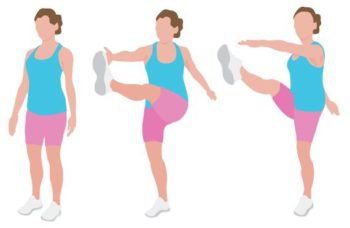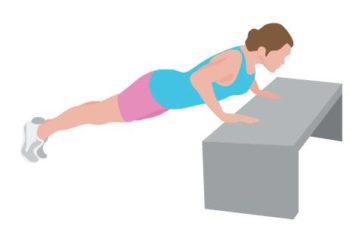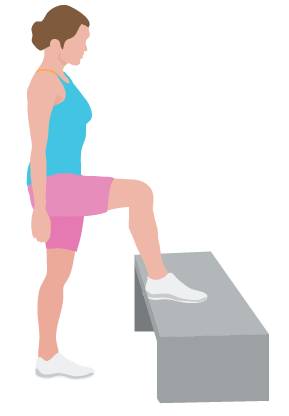Want to get fitter now? Nothing can stop you being the fittest, healthiest version of you – least of all age or ability, says fitness expert Lucy Wyndham-Read. “One of my fittest clients is in her late seventies and had suffered a stroke when I started working with her. Years on, she’s fighting-fit and has regained most of the movement she lost. There are two key areas that I worked on with her and which will make a big difference to you, too. These are fitness and strength,” she adds.
ALSO SEE: 5 new fitness classes to get fit, lean and strong
Yes you can get fitter and stronger! Here’s how
Flexibility
Flexibility training helps to strengthen your joints and prevent injuries; it also keeps you mobile, and improves your balance and agility. The more flexible you are, the more fluidity of movement through your body you’ll have, which naturally makes you look more elegant. Often, this is overlooked in favour of spending time on exercises that will get us in better shape – yet better flexibility will instantly make you look in better shape.
Strength training
“I also like to call this toning, and it’s such an important part of fitness, as it not only shapes and sculpts our body and increases our ability to burn fat, but, more importantly, it helps keep our bones strong and prevent osteoporosis,” says Lucy.
After the age of 30, our bone density starts to decline, and if you don’t do exercise, your bones can start to become weak and brittle. In addition, our muscle mass will start to decline, and this can cause weight gain – again, strength training will help to sort this out.
Your motivation
You can still regain strong bones and toned muscles, no matter what age you are. “When we do exercise that causes our body to resist against a weight, it drives a chemical process in the bones, which strengthens them; similarly, when we challenge our muscles, it helps to build stronger muscle fibres,” says Lucy.
Look at doing body-weight exercises at least three times a week – you can do these two important exercises anywhere. (Using your body’s own weight as resistance helps to tone muscles and strengthen bones).
ALSO SEE: How to rev up your treadmill workout
Add these to your daily routine
Reach for the stars
When you wake up, do the ‘grab some stars stretch’. Sit on the edge of your bed, with your feet placed firmly on the ground, hip-width distance apart, good body posture, and arms resting by your sides. Take a deep breath in and extend both arms up. Drop your fingertips out to the sides and push your palms up, then exhale and, at the same time, lift your hands back in, keeping arms as high as you can, as if you’re grabbing for a star. Hold, then slowly lower arms back down to the start position. Repeat several times.
Skip steps
Every time you take the stairs, take two at a time – this will help increase your flexibility through your hips.
On your toes
Tiptoes in the shower Stand straight, then extend your arms directly above your head. Come up onto your toes and hold this position for as long as you can, making yourself as tall as you can. Or, if you prefer to have a bath: while sitting in the bath, slowly walk your hands down the front of your legs, aiming to get your hands to your toes or beyond. Hold for 10 seconds at the furthest point, feeling the stretch in the back of your legs; do this flexibility stretch several times.
Sit and rotate
When you’re sitting at your desk, do a sitting-rotation move every half hour to ease stiffness in your back and help increase flexibility through your waist. Sit with good posture, and both feet placed firmly on the ground, then rotate from your waist round to one side, as if you’re looking behind you; hold, then rotate to look around the other shoulder.
Reach and reach again Place often-used food items, or even your clothing, in high places so that you have to stretch and really reach up to get them.
ALSO SEE: 5 Indoor Exercises To Keep You Fit Through Winter
Realign your spine
Before bed, stretch the body before you switch off for the night, to help realign it. Stand by your bed with your feet hip-width apart and parallel, and both of your arms relaxed by your sides. Extend one arm up directly above your head and then exhale, leaning very slightly to the opposite side from your raised arm. Hold this for a few seconds, then come back up the centre. Repeat with the opposite arm.
The windmill move
When you have a quiet moment within your day, complete my multitasking ‘Windmill Stretch and Tone’ move. It’s amazing for flexibility because it will stretch nearly all of your major muscles; plus it improves your balance, and also tones your legs, tum, bum and arms.

Start by standing upright with your feet hip-width apart and your knees slightly bent. Kick one leg directly out in front and, at the same time, swing the opposite arm out in front, aiming to reach your foot, with the other arm out behind you. Keep alternating from side to side and aim to do this 40 times a day. If you’re new to exercise, do 20 in the morning and 20 later in the day. Always make sure you have warmed-up before completing this move.
The push-up
This exercise strengthens the bones in your arms and chest, and tones and fires up the muscles in your arms, shoulders, chest and abs.

For complete beginners: stand facing a wall, take a big step back and then place your hands shoulder-width apart in line with your shoulders. Slowly lower yourself toward the wall, then push back up. Keep doing this to the point where it feels like a challenge, then do a few more of them.
When you feel stronger, lean into a bench and perform the same move. Aim to do this three times a week.
ALSO SEE: How old is your body? Plus, how to fix it
Step-ups
The benefit with this is that, again, like the previous exercise, you are using your body’s own weight as resistance. This will help to strengthen your bones, and stimulate and tone the muscles in your lower body.

Find a solid, sturdy raised surface, and simply step up and down; the higher the surface is, the harder this exercise will be. Aim to do this – alternating the leg you lead with each time – for one to two minutes.
Illustrations: Glen Wilkins

